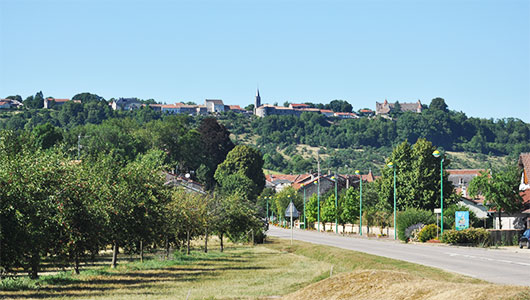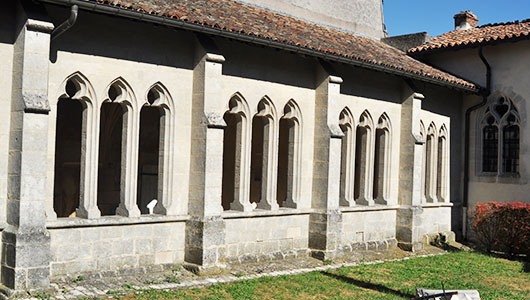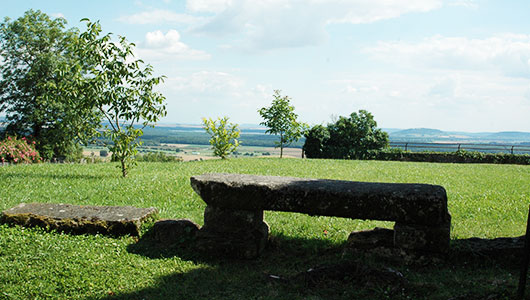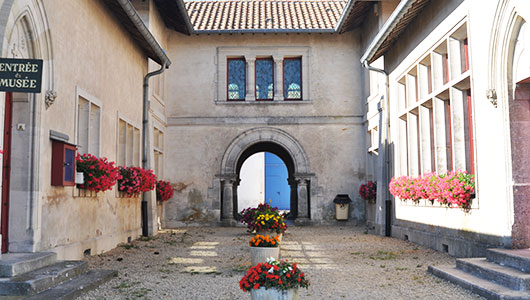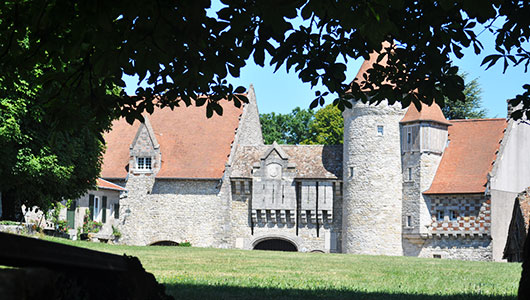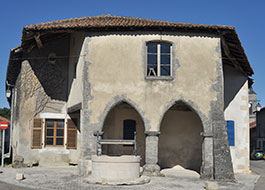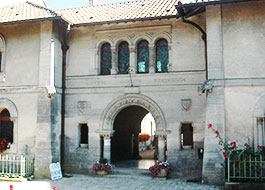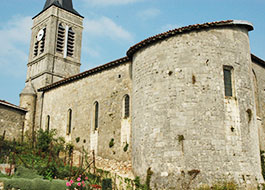Vigneulles-lès-Hattonchâtel
Durée visite : 60 min
Moyen : Pédestre
L’éperon barré de Bathélémont, à Hattonchâtel, et la découverte de pièces gauloises, sont les seuls indices antérieurs à la conquête romaine concernant les sept villages, qui composent la commune. À l’époque romaine, Hattonchâtel, au pied duquel s’étendent les village de Billy-sous-les-Côtes jusqu’à Creuë, est vraisemblablement un site fortifié . Des nécropoles mérovingiennes attestent la continuité de l’occupation du territoire. Vers 870, Hatton, évêque de Verdun, érige un château qui devient le site protecteur de la partie sud-est de l’évêché. Résidence des évêques et chef-lieu de prévôté, Hattonchâtel devient même chef-lieu de bailliage : les évêques y frappent la monnaie et y tiennent leurs grands jours de justice. Creuë est le siège d’une seigneurie possédant un château féodal. Vers 1130, Aimard de Reynel fonde l’abbaye de Saint-Benoît, qui procède à de nombreux défrichements et crée des étangs. Relevant du diocèse de Metz elle est dissoute à la Révolution. L’évêque de Verdun affranchit les habitants de Viéville, de Billy-sous-les-Côtes vers 1465 et ceux de Vigneulles en 1489. Hattonchâtel et sa prévôté sont cédés au duc de Lorraine en 1544, qui érige le domaine en marquisat pour son frère. Le village est plusieurs fois livré au pillage ; en 1634, Richelieu fait démanteler sa forteresse. Au XIXe siècle, l’essor de la vigne favorise une expansion démographique qui atteint son apogée vers 1850, suivie d’un déclin, dû notamment au phylloxéra et à la Grande Guerre. Pendant la Première Guerre mondiale, les sept villages sont l’objet de destructions, privations, prises d’otages et réquisitions. Vigneulles, Viéville, Hattonchâtel, Cruë, Hattonville, Billy-sous-les-Côtes et Saint-Benoît fusionnent en 1973, pour former la commune de Vigneulles-lès-Hattonchâtel. Le pôle touristique de Madine, l’implantation d’une fromagerie, la relance de la viticulture permettent une reprise de la vie économique.
The barred outcrop of Bathélémont, in Hattonchâtel, and the discovery of Gallic pieces, are the only clues prior to the Roman conquest concerning the seven villages which make up the town. In Roman times, Hattonchâtel, at the foot of which the villages of Billy-sous-les-Côtes extend as far as Creuë, is probably a fortified site. Merovingian necropolises attest to the continuity of the occupation of the territory. Around 870, Hatton, bishop of Verdun, erected a castle which became the protective site of the south-eastern part of the bishopric. Residence of the bishops and chief town of provost, Hattonchâtel even became the chief town of the bailiwick: the bishops minted the coins there and held their great days of justice. Creuë is the seat of a seigneury with a feudal castle. Around 1130, Aimard de Reynel founded the abbey of Saint-Benoît, which carried out numerous clearings and created ponds. Reporting to the diocese of Metz, it was dissolved during the Revolution. The bishop of Verdun freed the inhabitants of Viéville, Billy-sous-les-Côtes around 1465 and those of Vigneulles in 1489. Hattonchâtel and his provost were ceded to the Duke of Lorraine in 1544, who set up the estate as a marquisate for his brother . The village has been plundered several times; in 1634, Richelieu had his fortress dismantled. In the nineteenth century, the growth of the vine favored a demographic expansion which reached its peak around 1850, followed by a decline, due in particular to phylloxera and the Great War. During the First World War, the seven villages were the object of destruction, deprivation, hostage-taking and requisitions. Vigneulles, Viéville, Hattonchâtel, Cruë, Hattonville, Billy-sous-les-Côtes and Saint-Benoît merged in 1973 to form the municipality of Vigneulles-lès-Hattonchâtel. The tourist center of Madine, the establishment of a cheese dairy, the revival of viticulture allow a resumption of economic life.
Der vergitterte Aufschluss von Bathélémont in Hattonchâtel und die Entdeckung gallischer Stücke sind die einzigen Hinweise vor der römischen Eroberung in Bezug auf die sieben Dörfer, aus denen die Stadt besteht. In der Römerzeit ist Hattonchâtel, an dessen Fuß sich die Dörfer Billy-sous-les-Côtes bis nach Creuë erstrecken, wahrscheinlich eine befestigte Stätte. Merowinger-Nekropolen zeugen von der Kontinuität der Besetzung des Territoriums. Um 870 errichtete Hatton, Bischof von Verdun, eine Burg, die zur Schutzstätte des südöstlichen Teils des Bistums wurde. Hattonchâtel, die Residenz der Bischöfe und des Hauptortes Provost, wurde sogar zum Hauptort der Vogtei: Die Bischöfe prägten dort die Münzen und hielten ihre großen Tage der Gerechtigkeit ab. Creuë ist der Sitz einer Seigneury mit einer feudalen Burg. Um 1130 gründete Aimard de Reynel die Abtei Saint-Benoît, die zahlreiche Lichtungen durchführte und Teiche schuf. Sie berichtete der Diözese Metz und wurde während der Revolution aufgelöst. Der Bischof von Verdun befreite die Einwohner von Viéville, Billy-sous-les-Côtes um 1465 und die von Vigneulles im Jahr 1489. Hattonchâtel und sein Provost wurden 1544 an den Herzog von Lothringen abgetreten, der das Anwesen als Marquisat für seinen Bruder errichtete . Das Dorf wurde mehrmals geplündert; 1634 ließ Richelieu seine Festung abbauen. Im neunzehnten Jahrhundert begünstigte das Wachstum der Rebe eine demografische Expansion, die um 1850 ihren Höhepunkt erreichte, gefolgt von einem Rückgang, insbesondere aufgrund der Reblaus und des Ersten Weltkriegs. Während des Ersten Weltkriegs waren die sieben Dörfer Gegenstand von Zerstörung, Entbehrung, Geiselnahme und Beschlagnahme. Vigneulles, Viéville, Hattonchâtel, Cruë, Hattonville, Billy-sous-les-Côtes und Saint-Benoît schlossen sich 1973 zur Gemeinde Vigneulles-lès-Hattonchâtel zusammen. Das touristische Zentrum von Madine, die Gründung einer Käserei, die Wiederbelebung des Weinbaus ermöglichen eine Wiederaufnahme des Wirtschaftslebens.

De gueules à la vigne d’argent terrassée de même chargée en cœur d’un écusson de sable à la croix d’or.
Ce blason proposé par R. Louis a été adopté par la commune en 1957. La vigne et l’écusson de Hattonchâtel, d’ancienne chevalerie, font de ces armoiries des armes parlantes: Vigneulles sous Hattonchâtel. Avant d’être rattachée à la France, la commune faisait partie du temporel de l’évêché de Verdun. (UCGL)
A l’initiative de quelques élus du début des années 1970, et comme le prévoyait la loi « Marcellin », les Conseils Municipaux de 7 villages ont décidé de fusionner: Billy sous les Côtes, Creuë, Hattonchatel, Hattonville, Saint Benoît en Woëvre, Viéville sous les Côtes et Vigneulles.
Le 1er mars 1973, la nouvelle commune de Vigneulles les Hattonchatel a donc vu le jour.
Gules a silver vine on the floor of the same charged in the heart of an escutcheon of sand with the cross of gold.
This coat of arms proposed by R. Louis was adopted by the town in 1957. The vineyard and the Hattonchâtel coat of arms, a former knighthood, make these coat of arms talking arms: Vigneulles sous Hattonchâtel. Before being attached to France, the town was part of the temporary bishopric of Verdun. (UCGL)
At the initiative of some elected officials in the early 1970s, and as provided for in the “Marcellin” law, the Municipal Councils of 7 villages decided to merge: Billy sous les Côtes, Creuë, Hattonchatel, Hattonville, Saint Benoît en Woëvre, Viéville sous les Côtes and Vigneulles.
On March 1, 1973, the new commune of Vigneulles les Hattonchatel was therefore born.
Gules eine Silberrebe auf dem Boden derselben, die im Herzen eines Sandschildes mit dem Goldkreuz aufgeladen ist.
Dieses von R. Louis vorgeschlagene Wappen wurde 1957 von der Stadt angenommen. Der Weinberg und das Wappen von Hattonchâtel, ein ehemaliges Rittertum, lassen dieses Wappen Waffen sprechen: Vigneulles sous Hattonchâtel. Vor ihrer Zugehörigkeit zu Frankreich war die Stadt Teil des temporären Bistums Verdun. (UCGL)
Auf Initiative einiger gewählter Beamter in den frühen 1970er Jahren und gemäß dem „Marcellin“ -Gesetz beschlossen die Gemeinderäte von 7 Dörfern, sich zusammenzuschließen: Billy Sous Les Côtes, Creuë, Hattonchatel, Hattonville, Saint Benoît en Woëvre, Viéville sous les Côtes und Vigneulles. Am 1. März 1973 wurde daher die neue Gemeinde Vigneulles les Hattonchatel geboren.

Les habitants et les habitantes de la commune de Vigneulles-lès-Hattonchâtel s’appellent les Vigneullois et les Vigneulloises.
The inhabitants of the commune of Vigneulles-lès-Hattonchâtel are called the Vigneullois and the Vigneulloises.
Die Einwohner der Gemeinde Vigneulles-lès-Hattonchâtel heißen Vigneullois und Vigneulloises.

Le bar du château ambiance bon enfant et non conformiste à voir
Le lavoir
La maison à la voûte
The castle bar has a good-natured and non-conformist atmosphere to see.
The wash house
The house with the vault
Die Schlossbar bietet eine gutmütige und nonkonformistische Atmosphäre
Das Waschhaus
Das Haus mit dem Gewölbe
Les points de visites
.
La demeure de plan trapézoïdal, pourrait être le vestige d’un édifice plus grand. Elle comporte un niveau sur galerie ; les deux arcs ogivaux, l’un étant consolidé par un contrefort, reposent sur un pilier central cylindrique sans chapiteau. La galerie repose sur un solivage de chêne équarri. Du Moyen-Âge au XVIIIe siècle, c’est sous les arcades de cette maison, appelée le Châtelet, devant le grand puits, que le prévôt d’Hattonchâtel rend la justice.
The trapezoidal plan remains, could be the vestige of a larger building. It has a gallery level; the two pointed arches, one being consolidated by a buttress, rest on a cylindrical central pillar without a capital. The gallery rests on a squared oak joist. From the Middle Ages to the 18th century, it was under the arcades of this house, called the Châtelet, in front of the large well, that the provost of Hattonchâtel administered justice.
Der Trapezplan bleibt erhalten, könnte das Überbleibsel eines größeren Gebäudes sein. Es hat eine Galerieebene; Die beiden Spitzbögen, von denen einer durch einen Pfeiler verfestigt wird, ruhen auf einer zylindrischen zentralen Säule ohne Kapital. Die Galerie ruht auf einem quadratischen Eichenbalken. Vom Mittelalter bis zum 18. Jahrhundert verwaltete der Provost von Hattonchâtel unter den Arkaden dieses Hauses, das Châtelet genannt wurde, vor dem großen Brunnen.
.
.
La mairie a été détruite, comme une grande partie du village, lors de la guerre de 1914-1918. Miss Belle Skinner, américaine, bienfaitrice d’Hattonchâtel, contribua à relever les ruines après la guerre de 1914-1918. On lui doit la reconstruction du château, de la Mairie-école et du lavoir.
Sur la face arrière du bâtiment un petit jardin s’étale en strate. Depuis le belvédère, un panorama s’offre au visiteur sur le lac de la Madine.
The town hall was destroyed, like a large part of the village, during the 1914-1918 war. Miss Belle Skinner, American, benefactress of Hattonchâtel, contributed to raising the ruins after the war of 1914-1918. We owe him the reconstruction of the castle, the town hall-school and the wash house.
On the rear face of the building a small garden is spread out in stratum. From the belvedere, a panorama is offered to the visitor on the lake of Madine.
Das Rathaus wurde wie ein großer Teil des Dorfes während des Krieges von 1914 bis 1918 zerstört. Miss Belle Skinner, Amerikanerin, Wohltäterin von Hattonchâtel, trug nach dem Krieg von 1914-1918 zur Errichtung der Ruinen bei. Wir schulden ihm den Wiederaufbau des Schlosses, der Rathausschule und des Waschhauses.
Auf der Rückseite des Gebäudes ist ein kleiner Garten in Schichten verteilt. Vom Aussichtspunkt aus wird dem Besucher ein Panorama auf dem Madine-See angeboten.
.
L’église romane Saint-Rémi (XIIe,XIIIe, 1890, XXe siècles), menaçant de tomber en ruine, est restaurée en 1890 par le chanoine Paquet, curé de Vigneulles. À cette occasion, la nef est exhaussée au-dessus des arcades et le chœur relevé. Le chanoine fait ériger une chapelle en l’honneur du Sacré Cœur.Le retable du maître-autel est une copie, réalisée au XIXe siècle, de celui de Ligier Richier. L’église est relativement épargnée durant la Première Guerre mondiale, mais les vitraux doivent être remplacés : ils sont réalisés par le maître verrier Gruber. Les cloches ont été offertes par une famille de bienfaiteurs américains, les Taylor. Les anciennes cloches ont été emportées par les Allemands.
Le portail (XIIIe siècle) fait partie des éléments les plus anciens de l’église. La reconstruction, plusieurs fois reprise et abandonnée, expliquerait que le chœur primitivement roman, soit désaxé par rapport à la nef centrale et à la base du clocher ; certains veulent voir dans cette disposition architecturale, l’illustration de la tête penchée du Christ sur croix. La nef est composée de quatre travées des XIIIe et XIVe siècles ; la base clocher, la partie de la tribune, datant du XIIe siècle, présente une arcade encadrée de deux colonnes.
L’orgue (XIXe, XXe siècles, en bois de chêne, bois de sapin et étain), estimé à 4 000 francs en 1906, est constitué d’éléments d’époques différentes. Le buffet date du milieu du XIXe siècle ; la façade et les parois latérales sont en chêne, les panneaux en sapin. Après la disparition des tuyaux en métal durant la Première Guerre mondiale, la restauration s’organise en plusieurs étapes. En 1928, l’orgue possède 13 jeux et est équipé d’une soufflerie électrique. Les tuyaux de façade en étain comportent des écussons en plein cintre.
The Romanesque church of Saint-Rémi (12th, 13th, 1890, 20th centuries), threatening to fall into ruin, was restored in 1890 by Canon Paquet, parish priest of Vigneulles. On this occasion, the nave is raised above the arcades and the choir raised. The canon had a chapel erected in honor of the Sacred Heart. The altarpiece of the high altar is a copy, made in the 19th century, of that of Ligier Richier. The church was relatively untouched during the First World War, but the stained glass windows had to be replaced: they were made by the master glassmaker Gruber. The bells were donated by a family of American benefactors, the Taylors. The old bells were taken away by the Germans.
The portal (13th century) is one of the oldest elements of the church. The reconstruction, repeated and abandoned several times, would explain why the originally Romanesque choir is offset in relation to the central nave and the base of the bell tower; some want to see in this architectural arrangement, the illustration of the bent head of Christ on the cross. The nave is made up of four bays from the 13th and 14th centuries; the bell tower base, the part of the gallery, dating from the 12th century, has an arcade framed by two columns.
The organ (19th and 20th centuries, in oak wood, fir wood and pewter), estimated at 4,000 francs in 1906, is made up of elements from different periods. The sideboard dates from the middle of the 19th century; the front and side walls are in oak, the panels in fir. After the disappearance of the metal pipes during the First World War, the restoration is organized in several stages. In 1928, the organ had 13 stops and was equipped with an electric blower. The pewter facade pipes feature semicircular escutcheons.
Die romanische Kirche Saint-Rémi (12., 13., 1890, 20. Jahrhundert), die vom Verfall bedroht war, wurde 1890 von Canon Paquet, dem Pfarrer von Vigneulles, restauriert. Bei dieser Gelegenheit wird das Kirchenschiff über die Arkaden gehoben und der Chor angehoben. Der Kanon ließ eine Kapelle zu Ehren des Heiligen Herzens errichten. Das Altarbild des Hochaltars ist eine Kopie des Ligier Richier aus dem 19. Jahrhundert. Die Kirche war während des Ersten Weltkriegs relativ unberührt, aber die Buntglasfenster mussten ersetzt werden: Sie wurden vom Glasmachermeister Gruber hergestellt. Die Glocken wurden von einer Familie amerikanischer Wohltäter, den Taylors, gespendet. Die alten Glocken wurden von den Deutschen weggenommen. Das Portal (13. Jahrhundert) ist eines der ältesten Elemente der Kirche. Die Rekonstruktion, die mehrmals wiederholt und aufgegeben wurde, würde erklären, warum der ursprünglich romanische Chor in Bezug auf das Mittelschiff und die Basis des Glockenturms versetzt ist; Einige wollen in dieser architektonischen Anordnung die Darstellung des gebogenen Hauptes Christi am Kreuz sehen. Das Kirchenschiff besteht aus vier Buchten aus dem 13. und 14. Jahrhundert; Die Glockenturmbasis, der Teil der Galerie aus dem 12. Jahrhundert, hat eine Arkade, die von zwei Säulen eingerahmt wird. Die Orgel (19. und 20. Jahrhundert, aus Eichenholz, Tannenholz und Zinn), die 1906 auf 4.000 Franken geschätzt wurde, besteht aus Elementen aus verschiedenen Epochen. Das Sideboard stammt aus der Mitte des 19. Jahrhunderts; Die Vorder- und Seitenwände sind aus Eichenholz, die Paneele aus Tannenholz. Nach dem Verschwinden der Metallrohre während des Ersten Weltkriegs ist die Restaurierung in mehreren Schritten organisiert. 1928 hatte die Orgel 13 Register und war mit einem elektrischen Gebläse ausgestattet. Die Zinnfassadenrohre sind mit halbkreisförmigen Rosetten versehen.
.
L’étroitesse de la citadelle a imposé à l’église sa forme rectangulaire à chevet droit, son emplacement adossé à la muraille et son orientation nord-sud ; la tour ronde faisait partie intégrante des fortifications. Le portail du XVIe siècle encadre une porte divisée par un trumeau mouluré ; le linteau, supportant un tympan uni, était décoré avant 1914 de trois statues, désormais mutilées et scellées dans le mur nord.
La nef voûtée d’ogives et d’arcs doubleaux, compte quatre travées, séparées de piliers du XIVe siècle dont les chapiteaux ne sont pas sculptés ; les clefs de la voûte portent les armoiries de l’évêque Guillaume de Haraucourt. Les vitraux du XXe siècle ont été réalisés par Gruber.
LE CLOÎTRE.
La collégiale, créée en 1328, est à l’origine composée de onze chanoines, avec à leur tête un prévôt et un doyen ; elle est supprimée en 1709 pour être rattachée à la collégiale Saint-Léopold de Saint-Mihiel. Il ne subsiste de ce cloître qu’une galerie de cinq travées, percée de baies tréflées. Les clés de voûte gothiques représentent les armes de l’évêque Guillaume de Haraucourt.
LE RETABLE GOTHIQUE. Premier quart du XIVe siècle
Placé sur le maître-autel, le retable représente, sculptés en haut relief, des épisodes de la passion du Christ : la Flagellation, le Portement de croix, la Crucifixion, la Résurrection et l’Apparition à Madeleine. Il a été volontairement mutilé au moment de la Révolution. Il est transféré à Metz pendant la Première Guerre mondiale. Il réintègre la collégiale après la Seconde Guerre mondiale.
Le retable renaissance, datant de 1523, est attribué à Ligier Richier ou à l’école de Saint-Mihiel, ce retable, composé de six blocs de taille inégale, est fixé près du maître-autel jusqu’en 1791, puis placé dans la chapelle. Les trois compartiments, séparés par des pilastres évoquent des scènes de la passion du Christ. La partie centrale, surélevée est surmontée des armes de Louis de Lorraine, alors évêque de Verdun ; représente le Christ sur la croix et la Vierge en pâmoison, entourée de 3 soldats. Les parties latérales évoquent la chute du Christ sous la croix et la déposition de la croix. L’artiste a représenté au bas de cette dernière scène un prêtre à genoux, sans doute le donateur, et l’évêque de la collégiale.
The narrowness of the citadel imposed on the church its rectangular shape with a right apse, its location leaning against the wall and its north-south orientation; the round tower was an integral part of the fortifications. The 16th century portal frames a door divided by a molded trumeau; the lintel, supporting a united tympanum, was decorated before 1914 with three statues, now mutilated and sealed in the north wall.
The vaulted nave with ribs and double arches, has four bays, separated by pillars from the 14th century, the capitals of which are not carved; the keystones of the vault bear the coat of arms of Bishop Guillaume de Haraucourt. The stained glass windows of the twentieth century were made by Gruber.
THE CLOISTER.
The collegiate church, created in 1328, was originally made up of eleven canons, headed by a provost and a dean; it was abolished in 1709 to be attached to the collegiate church of Saint-Léopold de Saint-Mihiel. All that remains of this cloister is a gallery of five bays, pierced with trefoil bays. The Gothic keystones represent the arms of Bishop Guillaume de Haraucourt.
THE GOTHIC ALTERNATIVE. First quarter of the 14th century
Placed on the high altar, the altarpiece represents, sculpted in high relief, episodes of the passion of Christ: the Flagellation, the Carrying of the Cross, the Crucifixion, the Resurrection and the Apparition to Magdalene. He was voluntarily mutilated at the time of the Revolution. He was transferred to Metz during the First World War. He returned to the collegiate church after World War II.
The Renaissance altarpiece, dating from 1523, is attributed to Ligier Richier or to the school of Saint-Mihiel, this altarpiece, composed of six blocks of unequal size, is fixed near the high altar until 1791, then placed in the Chapel. The three compartments, separated by pilasters, evoke scenes from the Passion of Christ. The central, raised part is surmounted by the arms of Louis de Lorraine, then Bishop of Verdun; represents Christ on the cross and the Virgin swooning, surrounded by 3 soldiers. The side parts evoke the fall of Christ under the cross and the deposition from the cross. At the bottom of this last scene, the artist has represented a kneeling priest, undoubtedly the donor, and the bishop of the collegiate church.
Die Enge der Zitadelle zwang die Kirche zu ihrer rechteckigen Form mit einer rechten Apsis, ihrer an die Wand gelehnten Lage und ihrer Nord-Süd-Ausrichtung; Der runde Turm war ein wesentlicher Bestandteil der Befestigungsanlagen. Das Portal aus dem 16. Jahrhundert umrahmt eine Tür, die durch ein geformtes Trumeau getrennt ist. Der Sturz, der ein vereinigtes Tympanon trägt, wurde vor 1914 mit drei Statuen geschmückt, die jetzt verstümmelt und in der Nordwand versiegelt sind. Das mit Rippen und Doppelbögen gewölbte Kirchenschiff hat vier Buchten, die durch Säulen aus dem 14. Jahrhundert getrennt sind, deren Hauptstädte nicht geschnitzt sind. Die Grundsteine des Gewölbes tragen das Wappen von Bischof Guillaume de Haraucourt. Die Glasfenster des 20. Jahrhunderts wurden von Gruber hergestellt.
DER CLOISTER.
Die 1328 gegründete Stiftskirche bestand ursprünglich aus elf Kanonen, die von einem Provost und einem Dekan geleitet wurden. Es wurde 1709 abgeschafft, um an die Stiftskirche Saint-Léopold de Saint-Mihiel angegliedert zu werden. Von diesem Kreuzgang ist nur noch eine Galerie mit fünf Buchten übrig, die mit Kleeblattbuchten durchbohrt sind. Die gotischen Schlusssteine repräsentieren das Wappen von Bischof Guillaume de Haraucourt.
DIE GOTISCHE ALTERNATIVE. Erstes Viertel des 14. Jahrhunderts
Das auf dem Hochaltar platzierte Altarbild zeigt hochreliefierte Episoden der Passion Christi: die Geißelung, das Tragen des Kreuzes, die Kreuzigung, die Auferstehung und die Erscheinung der Magdalena. Er wurde zur Zeit der Revolution freiwillig verstümmelt. Er wurde während des Ersten Weltkriegs nach Metz versetzt. Nach dem Zweiten Weltkrieg kehrte er in die Stiftskirche zurück. Das Renaissance-Altarbild aus dem Jahr 1523 wird Ligier Richier oder der Schule von Saint-Mihiel zugeschrieben. Dieses Altarbild, das aus sechs ungleich großen Blöcken besteht, wird bis 1791 in der Nähe des Hochaltars befestigt und dann in den Altar gelegt Kapelle. Die drei durch Pilaster getrennten Abteilungen erinnern an Szenen aus der Passion Christi. Der zentrale, erhabene Teil wird von den Armen von Louis de Lorraine, dem damaligen Bischof von Verdun, überragt. stellt Christus am Kreuz und die Ohnmacht der Jungfrau dar, umgeben von 3 Soldaten. Die Seitenteile erinnern an den Fall Christi unter dem Kreuz und die Ablagerung vom Kreuz. Der Künstler hat am Ende dieser letzten Szene einen knienden Priester dargestellt, zweifellos den Spender und den Bischof der Stiftskirche.
.
Un premier château est édifié en 860 par Hatton, évêque de Verdun. Les deux ailes du bâtiment, flanquées de neuf tours, dessinent alors la cour, délimitée à l’Est par le mur du grand puits ; les entrées Est et Ouest sont aménagées en pont dormant et pont-levis. Remaniée du XIVe au XVIe siècle, la forteresse est démantelée en 1634 par Richelieu, puis reconstruite durant le XVIIIe. L’ancienne porte est détruite au début du XXe siècle ; Jacquelin réutilise l’arc en anse de panier, qui se trouvait à l’extrémité de l’ancien couloir d’entrée. Il refait la porte au niveau du sol, puis rouvre celle du premier étage. Elle donnait accès à l’ancienne chapelle des évêques.
Très endommagé lors de la Première Guerre mondiale, le château est restauré par l’architecte Jacquelin, pour le compte d’une américaine, Miss Skinner. L’aile nord est le seul vestige du château médiéval. Jacquelin réutilise des éléments de l’architecture antérieure : il dégage l’ancien fossé du IXe siècle, le vide et fait relever la contrescarpe ; trois tours sont remontées sur les fondations du Moyen Âge, et l’ancienne terrasse, qui n’existait plus depuis 1707, est réaménagée. Il imagine lui-même la tourelle d’angle hexagonale entre les deux ailes, qu’il dote d’une porte du XVe siècle, avec tympan et fleuron, provenant de la maison du doyen des chanoines. Le corps de logis s’élève sur des soubassements du Moyen Âge. Il conserve des fenêtres à meneaux de 1614.
The first castle was built in 860 by Hatton, Bishop of Verdun. The two wings of the building, flanked by nine towers, then outline the courtyard, bounded to the east by the wall of the large well; the east and west entrances are fitted out as a fixed bridge and a drawbridge. Remodeled from the 14th to the 16th century, the fortress was dismantled in 1634 by Richelieu, then rebuilt during the 18th century. The old door was destroyed at the beginning of the 20th century; Jacquelin reuses the basket-handle arch, which was at the end of the old entrance hall. He remakes the door at ground level, then reopens the one on the first floor. It gave access to the old bishops’ chapel.
Badly damaged during the First World War, the castle was restored by the architect Jacquelin, on behalf of an American, Miss Skinner. The north wing is the only vestige of the medieval castle. Jacquelin reuses elements of earlier architecture: he clears the old ninth century moat, empties it and raises the counterscarp; three towers have been reassembled on the foundations of the Middle Ages, and the old terrace, which no longer existed since 1707, has been redeveloped. He himself imagined the hexagonal corner turret between the two wings, which he fitted with a 15th century door, with tympanum and finial, coming from the house of the dean of the canons. The main building rises on foundations from the Middle Ages. It retains mullioned windows from 1614.
Die erste Burg wurde 860 von Hatton, Bischof von Verdun, erbaut. Die beiden Flügel des Gebäudes, flankiert von neun Türmen, umreißen dann den Innenhof, der im Osten von der Mauer des großen Brunnens begrenzt wird. Die Ost- und Westeingänge sind als feste Brücke und Zugbrücke ausgestattet. Die vom 14. bis 16. Jahrhundert umgebaute Festung wurde 1634 von Richelieu abgebaut und im 18. Jahrhundert wieder aufgebaut. Die alte Tür wurde zu Beginn des 20. Jahrhunderts zerstört; Jacquelin verwendet den Korbbogen wieder, der sich am Ende der alten Eingangshalle befand. Er macht die Tür im Erdgeschoss neu und öffnet dann die im ersten Stock wieder. Es gab Zugang zur alten Bischofskapelle.
Während des Ersten Weltkriegs schwer beschädigt, wurde das Schloss vom Architekten Jacquelin im Auftrag einer Amerikanerin, Miss Skinner, restauriert. Der Nordflügel ist der einzige Überrest der mittelalterlichen Burg. Jacquelin verwendet Elemente früherer Architektur wieder: Er räumt den alten Wassergraben aus dem 9. Jahrhundert, leert ihn und hebt den Gegenkarpfen an; Auf den Fundamenten des Mittelalters wurden drei Türme wieder aufgebaut, und die alte Terrasse, die seit 1707 nicht mehr existierte, wird saniert. Er selbst stellte sich den sechseckigen Eckturm zwischen den beiden Flügeln vor, den er mit einer Tür aus dem 15. Jahrhundert mit Tympanon und Endstück aus dem Hause des Dekans der Kanonen ausstattete. Das Hauptgebäude steht auf Fundamenten aus dem Mittelalter. Es enthält zweiflügelige Fenster aus dem Jahr 1614.

